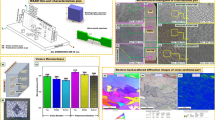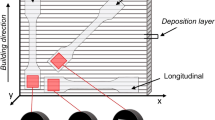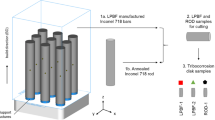Abstract
In this paper, 3 mm 6061 aluminum alloy sheets were welded by laser MIG hybrid welding. Based on the experiment, the best welding parameters were determined to ensure the penetration welding. The detailed microstructure, tensile and fatigue fracture morphology and surface fatigue damage of the welded joints were analyzed by optical microscope (OM), scanning electron microscope (SEM) and energy dispersive spectrometer (EDS). The results show that there are two main kinds of precipitates, one is the long Si rich precipitates at the grain boundaries, the other is the intragranular Cu rich precipitates. The tensile test results show that the tensile strength of the joint is 224 MPa, which is only 70.2% of the base metal. Through the analysis of tensile fracture, there are great differences in the formation of tensile dimple. In the tensile-tensile fatigue test with a stress rate of 0.1, the conditional fatigue limits of base metal and welded joint are 101.9 MPa and 54.4 MPa, respectively. By comparing the fatigue fracture of the welded joints under different stress amplitudes, it was found that the main factor leading to the fracture of the joint is porosity. Through further analysis of the pore defects, it was found that there are transgranular and intergranular propagation ways of microcracks in the pores, and the mixed propagation way was also found.
摘要
本文采用激光-MIG复合焊接技术对3 mm的6061铝合金板材进行焊接. 在实验的基础上, 确定了最佳的焊接工艺参数, 保证了熔透焊接. 采用光学显微镜(OM)、 扫描电镜(SEM)和能谱仪(EDS)对焊接接头的微观组织、 拉伸和疲劳断口形貌以及表面疲劳损伤进行分析. 结果表明, 焊接接头中存在两种主要析出相, 一种是晶界长的富Si沉淀相, 另一种是晶内富Cu沉淀相. 拉伸试验结果表明, 接头的抗拉强度为224 MPa, 仅为母材的70.2%. 通过对拉伸断口的分析, 发现母材与接头拉伸韧窝的形成有很大差异. 在应力率为0.1 的拉−拉疲劳试验中, 母材和焊接接头的条件疲劳极限分别为101.9和54.4 MPa. 通过对比不同应力幅下焊接接头的疲劳断口, 发现导致接头断裂的主要因素是气孔. 通过对孔隙缺陷的进一步分析, 发现孔隙中微裂纹的扩展方式有穿晶和沿晶两种, 并存在二者混合扩展方式.
Similar content being viewed by others
References
ZHANG Jin-liang, YE Jie-liang, SONG Bo, et al. Comparative study on microstructure and electrochemical corrosion resistance of Al7075 alloy prepared by laser additive manufacturing and forging technology [J]. Journal of Central South University, 2021, 28(4): 1058–1067. DOI: https://doi.org/10.1007/s11771-021-4679-9.
YAN Shao-hua, XING Bo-bin, ZHOU Hai-yang, et al. Effect of filling materials on the microstructure and properties of hybrid laser welded Al−Mg−Si alloys joints [J]. Materials Characterization, 2018, 144: 205–218. DOI: https://doi.org/10.1016/j.matchar.2018.07.018.
WANG Lei, GAO Ming, ZHANG Chen, et al. Effect of beam oscillating pattern on weld characterization of laser welding of AA6061-T6 aluminum alloy [J]. Materials & Design, 2016, 108: 707–717. DOI: https://doi.org/10.1016/j.matdes.2016.07.053.
ZHANG Long, LI Ke, HE Hong, et al. Influence of prolonged natural aging followed by artificial aging ontensile properties and compressive behavior of a thin-walled6005 aluminum alloy tube [J]. Journal of Central South University, 2021, 28(9): 2647–2659. DOI: https://doi.org/10.1007/s11771-021-4799-2.
de SALAZAR J M G, UREÑA A, VILLAURIZ E, et al. TIG and MIG welding of 6061 and 7020 aluminium alloys. Microstructural studies and mechanical properties [J]. Welding International, 1999, 13(4): 293–295. DOI: https://doi.org/10.1080/09507119909447381.
YAN Shao-hua, NIE Yuan, ZHU Zong-tao, et al. Characteristics of microstructure and fatigue resistance of hybrid fiber laser-MIG welded Al−Mg alloy joints [J]. Applied Surface Science, 2014, 298: 12–18. DOI: https://doi.org/10.1016/j.apsusc.2013.12.157.
LIANG Ying, HU Sheng-sun, SHEN Jun-qi, et al. Geometrical and microstructural characteristics of the TIG-CMT hybrid welding in 6061 aluminum alloy cladding [J]. Journal of Materials Processing Technology, 2017, 239: 18–30. DOI: https://doi.org/10.1016/j.jmatprotec.2016.08.005.
GAUR V, ENOKI M, OKADA T, et al. A study on fatigue behavior of MIG-welded Al−Mg alloy with different filler-wire materials under mean stress [J]. International Journal of Fatigue, 2018, 107: 119–129. DOI: https://doi.org/10.1016/j.ijfatigue.2017.11.001.
LIU Jia, ZHU Hong-yin, LI Zhong, et al. Effect of ultrasonic power on porosity, microstructure, mechanical properties of the aluminum alloy joint by ultrasonic assisted laser-MIG hybrid welding [J]. Optics & Laser Technology, 2019, 119: 105619. DOI: https://doi.org/10.1016/j.optlastec.2019.105619.
STEEN W M. Arc augmented laser processing of materials [J]. Journal of Applied Physics, 1980, 51(11): 5636–5641. DOI: https://doi.org/10.1063/1.327560.
YAN Shao-hua, CHEN Hui, ZHU Zong-tao, et al. Hybrid laser-metal inert gas welding of Al−Mg−Si alloy joints: Microstructure and mechanical properties [J]. Materials & Design, 2014, 61: 160–167. DOI: https://doi.org/10.1016/j.matdes.2014.04.062.
YAN Jun, ZENG Xiao-yan, GAO Ming, et al. Effect of welding wires on microstructure and mechanical properties of 2A12 aluminum alloy in CO2 laser-MIG hybrid welding [J]. Applied Surface Science, 2009, 255(16): 7307–7313. DOI: https://doi.org/10.1016/j.apsusc.2009.03.088.
TANG Guo, CHEN Hui, YANG Xiao-yi, et al. Effects of different welding process on the electronic temperature of plasma and weld shape during laser-MIG hybrid welding of A7N01P-T4 aluminum alloy [J]. Journal of Laser Applications, 2018, 30(2): 022002. DOI: https://doi.org/10.2351/1.5004434.
HAN Xiao-hui, YANG Zhi-bin, MA Yin, et al. Porosity distribution and mechanical response of laser-MIG hybrid butt welded 6082-T6 aluminum alloy joint [J]. Optics & Laser Technology, 2020, 132: 106511. DOI: https://doi.org/10.1016/j.optlastec.2020.106511.
YONETANI H. Laser-MIG hybrid welding to aluminium alloy carbody shell for railway vehicles [J]. Welding International, 2008, 22(10): 701–704. DOI: https://doi.org/10.1080/09507110802465050.
PAIL K. Usability of Laser-Arc hybrid welding processes in industrial applications [D]. Finland, Lappeenranta: University of Lappeenranta Technology, 2011. https://www.researchgate.net/publication/266576970.
OLA O T, DOERN F E. Keyhole-induced porosity in laser-arc hybrid welded aluminum [J]. The International Journal of Advanced Manufacturing Technology, 2015, 80(1–4): 3–10. DOI: https://doi.org/10.1007/s00170-015-6987-4.
WANG Jing-bo, NISHIMURA H, FUJII K, et al. Study of improvement of gap tolerance in laser MIG arc hybrid welding of aluminium alloy [J]. Welding International, 2009, 23(10): 723–733. DOI: https://doi.org/10.1080/09507110902836879.
ASCARI A, FORTUNATO A, ORAZI L, et al. The influence of process parameters on porosity formation in hybrid LASER-GMA welding of AA6082 aluminum alloy [J]. Optics & Laser Technology, 2012, 44(5): 1485–1490. DOI: https://doi.org/10.1016/j.optlastec.2011.12.014.
WANG Lei, LIU Yao, YANG Cheng-gang, et al. Study of porosity suppression in oscillating laser-MIG hybrid welding of AA6082 aluminum alloy [J]. Journal of Materials Processing Technology, 2021, 292: 117053. DOI: https://doi.org/10.1016/j.jmatprotec.2021.117053.
CHEN Rong, JIANG Ping, SHAO Xin-yu, et al. Effect of magnetic field on crystallographic orientation for stainless steel 316L laser-MIG hybrid welds and its strengthening mechanism on fatigue resistance [J]. International Journal of Fatigue, 2018, 112: 308–317. DOI: https://doi.org/10.1016/j.ijfatigue.2018.03.034.
LIU Hao-bo, YANG Shang-lei, XIE Chao-jie, et al. Microstructure characterization and mechanism of fatigue crack initiation near pores for 6005A CMT welded joint [J]. Materials Science and Engineering A, 2017, 707: 22–29. DOI: https://doi.org/10.1016/j.msea.2017.09.029.
DUAN Chen-feng, YANG Shang-lei, GU Jia-xing, et al. Study on microstructure and fatigue damage mechanism of 6082 aluminum alloy T-type metal inert gas (MIG) welded joint [J]. Applied Sciences, 2018, 8(10): 1741. DOI: https://doi.org/10.3390/app8101741.
GU Jia-xing, YANG Shang-lei, XIONG Qi, et al. Microstructure and mechanical study on laser-arc-welded Al−Zn−Mg alloy [J]. Materials Transactions, 2020, 61(1): 119–126. DOI: https://doi.org/10.2320/matertrans.mt-m2019178.
BAKER K L, WARNER D H. An atomistic investigation into the nature of near threshold fatigue crack growth in aluminum alloys [J]. Engineering Fracture Mechanics, 2014, 115: 111–121. DOI: https://doi.org/10.1016/j.engfracmech.2013.10.019.
HUANG Yi, HUANG Jian, NIE Pu-lin. Microstructures and textures of 6016 and 5182 aluminum laser welded joints [J]. Chinese Journal of Lasers, 2019, 46(4): 50–56. (in Chinese)
ZHAN Xiao-hong, ZHAO Yan-qiu, LIU Ze-min, et al. Microstructure and porosity characteristics of 5A06 aluminum alloy joints using laser-MIG hybrid welding [J]. Journal of Manufacturing Processes, 2018, 35: 437–445. DOI: https://doi.org/10.1016/j.jmapro.2018.08.011.
ZHONG Qun-peng, ZHAO Zi-hua. Fractography [M]. Higher Education Press, Beijing, 2006: 146–155. https://max.book118.com/html/2017/0419/101183533.shtm. (in Chinese)
CHANG Yi-ling, HUNG F Y, LUI T S. Enhancing the tensile yield strength of A6082 aluminum alloy with rapid heat solutionizing [J]. Materials Science and Engineering A, 2017, 702: 438–445. DOI: https://doi.org/10.1016/j.msea.2017.07.021.
QIAO Ke, WANG Kuai-she, WANG Wen, et al. Low-cycle Fatigue Properties of Friction Stir Welding Joint of AZ31 Magnesium [J]. Rare Metal Materials and Engineering, 2019, 48(3): 788–796.
LIN Sen, DENG Yun-lai, TANG Jian-guo, et al. Microstructures and fatigue behavior of metal-inert-gas-welded joints for extruded Al−Mg−Si alloy [J]. Materials Science and Engineering A, 2019, 745: 63–73. DOI: https://doi.org/10.1016/j.msea.2018.12.080.
ZHAO Yan-qiu, ZHOU Xu-dong, LIU Ting, et al. Investigate on the porosity morphology and formation mechanism in laser-MIG hybrid welded joint for 5A06 aluminum alloy with Y-shaped groove [J]. Journal of Manufacturing Processes, 2020, 57: 847–856. DOI: https://doi.org/10.1016/j.jmapro.2020.07.044.
FENG Lei, XUAN Fu-zhen. Effect of non-metallic inclusions on the local stress concentration within materials [J]. Journal of Mechanical Engineering, 2013, 49(8): 41–48. DOI: https://doi.org/10.3901/JME.2013.08.041. (in Chinese).
MUGHRABI H. Specific features and mechanisms of fatigue in the ultrahigh-cycle regime [J]. International Journal of Fatigue, 2006, 28(11): 1501–1508. DOI: https://doi.org/10.1016/j.ijfatigue.2005.05.018.
Author information
Authors and Affiliations
Contributions
FAN Cong was responsible for experiments and paper writing; YANG Shang-lei conducted the literature review; DUAN Chen-feng, ZHU Min-qi and BAI Yi-shan were in charge of the whole trial. All authors read and approved the final manuscript.
Corresponding author
Ethics declarations
The authors declare that they have no known competing financial interests or personal relationships that could have appeared to influence the work reported in this paper.
Additional information
Foundation item: Project(51971129) supported by the National Natural Science Foundation of China; Project(19ZR1421200) supported by the Shanghai Natural Science Foundation, China
Rights and permissions
About this article
Cite this article
Fan, C., Yang, Sl., Duan, Cf. et al. Microstructure and mechanical properties of 6061 aluminum alloy laser-MIG hybrid welding joint. J. Cent. South Univ. 29, 898–911 (2022). https://doi.org/10.1007/s11771-022-4954-4
Received:
Accepted:
Published:
Issue Date:
DOI: https://doi.org/10.1007/s11771-022-4954-4




